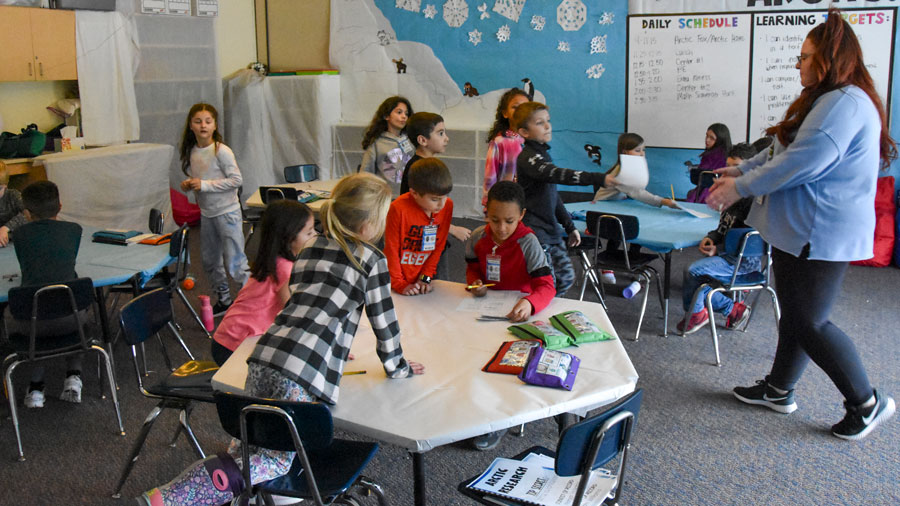Grandville — December in Michigan can sometimes feel like the Arctic Circle, and that was definitely the case for students in Megan Gallagher’s second-grade class at Century Park Learning Center.
For the last week of school before the holiday break, Gallagher’s classroom was “the Arctic room,” with frosty lights, a little igloo in the corner and books about Arctic animals. In the background, a video played on the big screen featuring glaciers, birds, ocean waves and frolicking polar bears.
Not only that, but Gallagher gave every lesson for the week an Arctic theme — everything from vocabulary to math to following directions — and had students work in small groups to build their collaboration skills.
The point of the transformation, Gallagher said, was to “transport students to a new place while teaching them new concepts and reviewing old concepts without them even realizing it,” she said. “It takes us out of the monotony of our weekly routine.”

At one table, Hannah Elenbaas, Charlotte Munoz, Liam Williams and Keegan Williams had just finished a vocabulary assignment, learning words like prey, omnivore and echolocation. Gallagher handed out notecards for their next lesson and the four huddled around their small table to see what their next adventure would be.
“A baby penguin has been taken!” the notecard read. “Please complete the tasks to bring him home!”
Beneath this missive was a page full of math word problems. The assignment was set up as a scavenger hunt throughout the school building, incorporating math problems, animal habitats and Arctic vocabulary into the clues.
“Remember to work together,” Gallagher called out, walking around the small groups. But the students didn’t need to be asked twice; they jumped into action to figure out the answers. After all, a baby penguin had been taken, and they had to complete all the math problems to get to the next clue!
‘I think that kids need a break every once in a while, (but) that doesn’t have to mean stopping content all together. It just means finding new and interesting ways to engage students and make learning fun for them again.’
– second-grade teacher Megan Gallagher
“We’re learning about the animals in the Arctic,” Liam told a visitor as his group worked on the scavenger hunt clues. “Things like what they do, what they eat. I like that these animals can go to places without getting super cold.”
At another table, Nik Kanczuga and classmates in his small group were studiously cutting out words from a piece of paper labeled “Contractions”. They had already done some research about the Arctic fox and the Arctic hare, and were moving on to the grammar portion of the lesson.
“When you put a word together with another word and it is shorter — that’s a contraction,” Nik explained. “For example, the word ‘do’ and the word ‘not’ can go together; that’s when you get ‘don’t.’ We’re going to have some facts about the Arctic fox and the Arctic hare and use some of these words.”
While transforming a room and a week’s worth of lessons into an Arctic scene takes some extra work, Gallagher said her biggest reward is the increased student engagement she sees all week.
“I usually get moans and groans … during the average week, but during this week they can’t wait to share what they’ve learned,” she said. “The kids never know what to expect, and it’s a lot of fun for me as well.
“I think that kids need a break every once in a while, (but) that doesn’t have to mean stopping content all together. It just means finding new and interesting ways to engage students and make learning fun for them again.”












